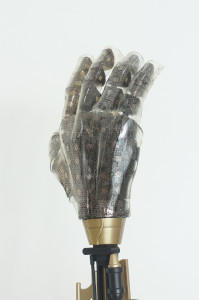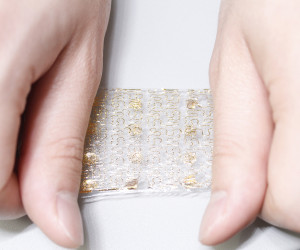
The skin is embedded with ultrathin, single crystalline silicone nanoribbon, which enables an array of sensors.
Credit: Kim et al./Nature Communications
We’ve talked about the advancements in prosthetic limbs in the past, but now a group of researchers out of Seoul National University are taking innovation in prosthetics one step further with this new “smart skin.”
Researchers from the Republic of Korea have developed a stretchy synthetic skin embedded with sensors, which will be able to help those with prosthetics regain their sense of touch.
This from “Stretchable silicon nanoribbon electronics for skin prosthesis” in the journal Nature Communications:
This collection of stretchable sensors and actuators facilitate highly localized mechanical and thermal skin-like perception in response to external stimuli, thus providing unique opportunities for emerging classes of prostheses and peripheral nervous system interface technologies.
In the experiments, the “smart skin” – prosthetic skin embedded with electrons – was laminated onto prosthetic hands.
The ultimate goal of the project is to make a synthetic skin with many of the same properties as human skin, such as warmth, softness and elasticity.
The skin was sensitive to pressure, stretching, temperature and dampness – and can perform such tasks as shaking hands, grasping baseballs, holding hot or cold drinks, and touching other people.

The proposed prosthetic skin can be stretched freely up to 50 percent.
Credit: Kim et al./Nature Communications
Similar projects in the past have struggled due to sensor limitations. Outcomes that have produced high sensitivity typically resulted in a small range of measurements, and vice versa.
However, the sensors used in the new synthetic skin are made of silicon ribbons, which have a snake-like shape. Due to this, the skin will be able to withstand more strain.
This from Live Science:
The scientists also combined their electronic skin with an array of stretchable platinum electrodes that would stimulate nerves to relay sensor data to the brain. These electrodes were coated with microscopic particles of cerium oxide to help control the inflammation that such electrodes can trigger in the body. In experiments with rats, the researchers showed this electrode array could transmit data about the pressure of a touch to the brain.
Are you a researcher in the field of sensor technology? If so, make sure to check out ECS’s Sensor Division.
Also, make sure to stay on top of current trends in sensor technology by accessing the latest research in our Digital Library.


